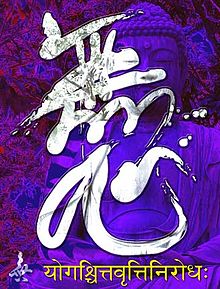- Muga-mushin
-
 Still the patterning of consciousness![1]
Still the patterning of consciousness![1]
Muga-mushin (無我無心) is a compound term of muga and mushin. Muga literally means no-self[2] (derived from the Sanskrit anātman) and Mushin no-mind[3] (also from the Sanskrit a-citta). What is negated is the empirical body-mind as an ontological independent state of existence. Muga and mushin point to the same thing, the state of egolessness, but from different perspectives. Muga refers to the negation of the physical state, mushin to the mental state of empirical existence.
To understand better mushin one needs to understand acitta, or simply its Sanskrit-root citta. Citta is not easily rendered into English. As is the case with so many other Sanskrit terms, there does not seem to be a precise equivalent for it in English. Previous translations have proposed a variety of renderings, such as 'mind-stuff', 'thinking-principle', and similar compound words. In many instances, citta seems to convey consciousness, mind, intellect or psychic mass that orders and illuminates sensations coming from without—can serve as a mirror for objects, without the senses interposing between it and its object. Thus the non-initiate is incapable of gaining freedom, because his mind, instead of being stable (still, non-fluctuating) is constantly violated by the activity of the senses, by the subconscious, and by the 'thrust for life'.
Reductionistic steps in the volution of muga-mushin concept and application
- 7. Samkhya – Mystical Tradition[4]
- 6. Yoga – First Level of Reduction.[1] Note that the words 'mārga'/'dō' and 'yoga' are interchangeable.
- 5. Buddhism – Second Level of Reduction[5]
- 4. Chan/Zen – Third Level of Reduction[6]
- 3. Budō/Bujutsu – Fourth Level of Reduction[7] – cultivation muga-mushin (revealed as heijō-shin).
- 2. Modern Kendo – Fifth Level of Reduction[8]
- 1. Olympic sports – Sixth Level of Reduction[9] – Combat sports as well as non-combat (baseball, basketball, swimming etc.)[10]
See also
- Budō, Bushido, Martial arts
- Fudoshin
- Kizeme
- Unconscious mind
- Shinjin (信心)
- Shunyata
- Zen Buddhism
References
- ^ a b The Yoga-Sutra of Patanjali by Georg Feuerstein. Inner Traditions International, Rochester, Vermont, 1989.
- ^ Muga (無我:[むが], selflessness, self-effacement, self-renunciation) Jim Breen's WWWJDIC Japanese Dictionary Server
- ^ Mushin (無心:[むしん], innocent) Jim Breen's WWWJDIC Japanese Dictionary Server
- ^ Yoga, Immortality and Freedom by Willard R. Trask. Bollingen Series LVI, Princeton University Press, 1990.
- ^ Zen and Confucius in the Art of Swordmanship by Reinhard Kammer. Routledge & Kegan Paul, 1978.
- ^ Zen, The way of the Sword by Winston L. King. Oxford University Press, 1993
- ^ Samurai Strategies by Boye lafayette De Mente. Tittle Publishing, 2005.
- ^ Kendo, Its Philosophy History and Means to Personal Growth by Minoru Kiyota. Kegan Paul International, 1995, p. 3
- ^ Modern Educational Theories and Traditional Japanese Martial arts Training Methods by John J. Donohue. Journal of Asian Martial Arts 14(2), 2005.
- ^ SPORTS, The Complete Visual Reference by Fraçois Fortin, Firefly Books, 2000, p. 295.
Buddhism Categories:- Japanese martial arts terms
- Zen terms
- Kendo
Wikimedia Foundation. 2010.
